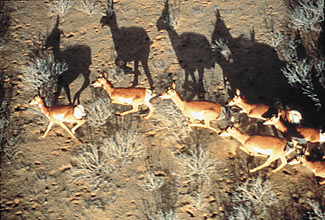|
A Look at Life: Forms Wonderful and Beautiful
La Perspectiva de la Vida: Formas Bellas y Maravillosas
The forms of life make sense when viewed through the lens of natural selection. Under stress, forms can be pushed, stretched, or squashed; genetic accidents crop up, and survival and successful reproduction define the next generation. As landscapes and climates change, plants and animals adapt or become extinct. In greater Baja California, the climate can be harsh and variable. Cycles of abundance and scarcity alternate from land to sea. The ability to survive these cycles will decide the fate an individual, perhaps of an entire species.

Osprey and nest
Pablo Cervantes
Ospreys, also known as fish eagles, depend on the riches of the sea to sustain their families. During El Niño years, when fish are scarce, osprey chicks become scarce as well.

Peninsular pronghorn
Patricio Robles Gil
The pronghorn's strategy for survival is to migrate in search of adequate food. Competition with domestic livestock and fragmentation of habitat have pushed the peninsular pronghorn to the brink; numbers in the wild are estimated at less than two hundred.
|
![[Desert and Sea: Visions of Baja California - El Desierto y el Mar: Imagenes de Baja California]](images/bnr-desertandsea-anim.gif)

![[Desert and Sea: Visions of Baja California - El Desierto y el Mar: Imagenes de Baja California]](images/bnr-desertandsea-anim.gif)
